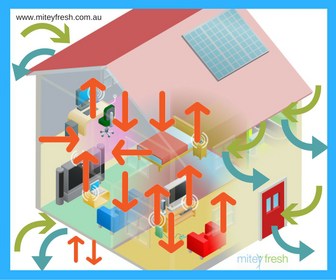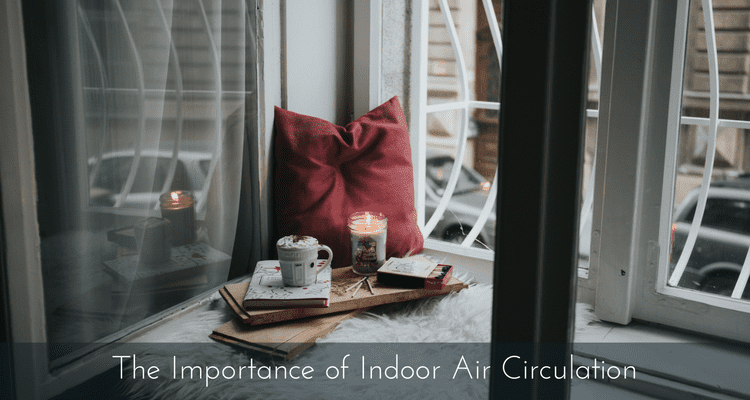I developed a 3-step process to taking care of your indoor air quality: The 3 C’s to Quality Indoor Air. They include circulation, cleaning and comfort.
Circulation, also known as ventilation or air flow or air exchange, is the first step in the process. Air circulation plays a major role in all parts of the process. Circulation of the air in the room or building allows you to filter your air, which is cleaning. It also helps to diffuse or spread the pollutants added to the air, like stirring milk in your coffee and drinking it.
All three steps are necessary for proper indoor air quality, however, without circulation the other two steps would be nearly impossible.
What Makes Good Indoor Air Circulation?
Every room should have windows and doors, at the very least. Circulating the air into the space is performed by your building’s gaps. The gaps suck in the air from the outside of the building, from under the flooring and the roof cavity and vice versa.

Once the air is sucked in via the gaps, it passes through the open windows, doors, cracks and into your space. Diffusing the room’s air is performed by building materials, objects and space around them. Interior materials act as sinks, absorbing contaminants from the air and later releases it when levels are lowering. Like a sponge absorbs water and over time dries out. The diffused air is exchanged out through the open windows, removing out particulates and gases that are making your air polluted.
Sealed spaces equipped with a Heating or Air Conditioning system, filter and mechanically circulate the air. The system conditions the air from inside the space after it passes through the fan via the filter. Air is then pushed back into your room, without the larger particulates.
Your return supply air vents should be located in multiple rooms, if they’re not I would suggest getting a licensed professional to assess for you. The whole process is circulation of the building’s air.
How to Improve Air Circulation
Its good practice to move furnishings and clutter in a direction that will stir the air (like dunking a biscuit in your coffee) in your space, hence, ventilate, air flow, circulate, exchange.
If your space has one gap, it’s a good idea to keep it open at all times. This will circulate the air and also mix the air to flow in the space to the outside, this is particularly important under the house in the sub floor cavity.
Stagnant Areas
Stagnant areas are spots in your space or home or building that have poor circulation. Some common spots are:
- Behind your curtains
- Behind your furnishings, against walls like your lounge or bed or desk
- Unoccupied, closed-up rooms
- Cupboards
- Corners of rooms
- Cluttered rooms
- Objects blocking air flow
Sometimes these stagnant areas are unavoidable. You can do your best to open cupboards and clear clutter to improve these spaces, but you may just have to take care of these areas manually. This is why it’s important to always have a damp micro fiber cloth handy to freshen those areas.
De-cluttering
This is a major part of air circulation. Every space is going to have a few stagnant spots, so practising good air circulation includes de-cluttering your space. You should move furnishings and objects in your space, at least once every six months. De-cluttering and cleaning stagnant areas and other areas of your building helps to keep dust, mould and bacteria at bay. It gets these particulates away instead of clinging to furnishings, so that your ventilation system will have an opportunity to ventilate them out.
Determine Your HVAC Exchange Rate
The exchange rate is the volume of air it takes to exchange or replace in your space through the Heating Ventilation Air Conditioning system or air purifier in one hour. It is not necessary to know this number for residential. However, your HVAC professional can certainly do the maths if you are concerned for commercial. If you don’t want to find out this number, a general rule of thumb is run your HVAC only when windows and doors are closed. For commercial premises, run the system when the building is occupied. Using a heat load calculation determines the size of the system for that space.
Circulation, ventilation, air flow or air exchange, is very important in quality indoor air. It’s easy to do since open windows and doors do all the work for you. Just make sure you:
- Open the windows and doors 24 hours a day
- Keep spaces clear of clutter
- Move objects
- De-clutter, dust and vacuum your rooms at least once a week and move the furnishings and hit all the stagnant areas
- Angle your HVAC system and / or fan(s) to spin the air in a circular motion around the space
My 3 Cs to quality indoor air control: circulation, cleaning and comfort. I suggest you read these posts to understand how to keep your quality indoor air:
The Nature of Indoor Air Quality
The Nature of Indoor Air Quality was added because you should know what you’re working with before you get started.
Towards healthier living, Carol Parr ♥
As Building Biologists, we have acquired knowledge of adverse health effects and recommend effective strategies to reduce occupants’ exposure by eliminating and controlling as many sources of pollutants in order to create healthy indoor living environments that are as exposure-free and natural as practically possible.
I encourage you to have conversations about Air Purification and ask questions on the Mitey Fresh Facebook page, other people may well be wondering the same thing, and I will do my best to answer them there.
Author
-
We’re glad you’re here. We’re Carol and Tony, founders of one of the longest running Healthy Home Blogs in the world, Mitey Fresh Australia. We’ve been on this journey for the last 25 years and are passionate about helping families sift through health hazards and triggers like allergens, mould, water damage, chemicals and EMFs, to get clarity about what’s toxic and what’s not so they can create a healthy and happy home for their family they love. Each month, people visit this blog seeking focus on the health and wellbeing of their loved ones, sustainable and effective practice tips and guides, to help create and manage healthier indoor spaces, improve the built environment that is pleasing to the senses and support healthy living and nature, every day. Starting this blog was to help change people’s lives, one family at a time, and we can’t wait to share how its allowed us to stand next to you and show you how interpreting these synergies between buildings and the environment they are built in will impact upon the health and well-being of those who occupy them. Find out more about Healthy Homes and what this blog can do for you!






Thanks for pointing out that you could angle your fans or HVAC system to spin the air in a circular motion around the space. As you said, airflow or air exchange, ventilation, and circulation are very important for quality indoor air. This reminds me of buildings and warehouses that are in enclosed spaces. I could imagine how helpful it would be for them to have a professional install industrial fans in order to keep proper ventilation while workers are working to keep them safe.